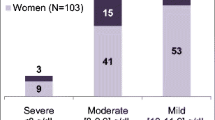Summary
Tumor anemia is very common in patients with cancer. The causes are very diverse and the parameter value depends on several factors. If this however develops to be symptomatic it may adversely impact health related quality of life. Erythropoietin or blood transfusion provides options for treatment. However, these are not always uneventful. There could also be a lack of response to Erythropoietin. This case report describes the complexity of tumor anemia. It also includes a more detailed discussion on the Fatigue Syndrome, which is one of the most common symptoms of patients with cancer. In the context of palliative care there is often the question of alternatives for improving the quality of patients life. Some kinds of treatment may also cause the opposite effect. A multidimensional assessment should help to approach this difficult issue and to find ways for a meaningful treatment of the symptoms of anemia.
Zusammenfassung
Bei Karzinompatienten kommt es im Rahmen der Erkrankung häufig zum Auftreten einer Tumoranämie. Die Ursachen sind vielfältig, und die Ausprägung hängt von mehreren Faktoren ab. Wenn diese jedoch symptomatisch wird, geht sie mit einer massiven Einschränkung der Lebensqualität einher. Eine Möglichkeit zur Behandlung stellen Erythropoietine oder Erythrozytenkonzentrate dar. Diese sind jedoch nicht komplikationslos, zudem kann es zu einem fehlenden Ansprechen auf Erythropoietine kommen. Im Rahmen dieser Arbeit wird anhand eines Fallberichtes die Komplexität der Tumoranämie dargestellt. Weiters wird näher auf das Fatiguesyndrom eingegangen, welches häufig mit der Tumoranämie in Verbindung gebracht wird. Im Rahmen der Palliativmedizin stellt sich zudem häufig die Frage, welche Behandlungsmethoden dem Patienten Lebensqualität geben und welche diese einschränken. Ein multidimensionales Assessment bietet eine Hilfestellung, um sich diesem Thema zu nähern und zu einer sinnvollen Behandlungsentscheidung zu gelangen.
Similar content being viewed by others
Literatur
Pohl GM, Ludwig H. Supportive treatment for anemic cancer patients. Wien med Wochenschr, 154: 226–234, 2004
Dicato M, Plawny L, Diederich M. Anemia in cancer. Ann Oncol, 21: 167–172, 2010
Stone P, Richards M, Hardy J. Fatigue in patients with cancer. Eur J Cancer, 34: 1670–1674, 1998
Aaronson NK, Ahmedzai S, Bergmen B, et al. The European Organization for Research and Treatment of Cancer QLQ-C30: a quality-of-life instrument for use in international clinical trials in oncology. J Natl Cancer Inst, 85: 365–376, 1993
De Haes JC, Van Kippenberg FC, Neijt JP. Measuring psychological and physical distress in cancer patients: structure and application of the Rotterdam Symptom Checklist. Br J Cancer, 62: 1034–1038, 1990
Jonas S, Wild C. Erythropoietin bei Tumoranämie – ein Assessment. ITA Projektbericht, Österreichische Akademie der Wissenschaften, 2000
Boccia R, Lillie T, Tomita D, Balducci L. The effectiveness of darbepoetin alfa administered every 3 weeks on hematologic outcomes and quality of life in older patients with chemotherapy-induced anemia. Oncologist, 12: 584–593, 2007
Spivak JL, Gascón P, Ludwig H. Anemia management in oncology and haematology. Oncologist, 14(Suppl 1): 43–56, 2009
Hilarius DL, Kloeg PH, Van der Wall E, et al. Cancer related fatigue: clinical practice versus practice guidelines. Support Care Cancer, 19: 531–538, 2011
Gleeson C, Spencer D. Blood transfusion and its benefits in palliative care. Palliat Med, 9: 307–313, 1995
Brown E, Bennett M. Survey of blood transfusion practice for palliative care patients in Yorkshire: implications for clinical care. J Palliat Med, 10: 919–922, 2007
Radbruch L, Strasser F, Elsner F, et al. Research Steering Comittee der EAPC, Fatigue in palliative care patients – an EAPC approach. Palliat Med, 22: 13–23, 2008
Mercadante S, Ferrera P, Villari P, et al. Effects of red blood cell transfusion on anemia-related symptoms in patients with cancer. J Palliat Med, 12: 60–63, 2009
Martinsson U, Lundström S. The use of blood transfusions and erythropoietin-stimulating agents in Swedish palliative care. Support Care Cancer, 17: 199–203, 2009
Lindholm E, Daneryd P, Körner P, et al. Effects of recombinant erythropoietin in palliative treatment of unselected cancer patients. Clin Cancer Res, 10: 6855–6864, 2004
Strasser F, Müller-Käser I, Dietrich D. Evaluating cognitive, emotional, and physical fatigue domains in daily practice by single-item questions in patients with advanced cancer: a cross-sectional pragmatic study. J Pain Symptom Manage, 38: 505–514, 2009
Author information
Authors and Affiliations
Corresponding author
Rights and permissions
About this article
Cite this article
Altinger, M., Strasser, F. Tumoranämie im palliativen Kontext. Wien Med Wochenschr 162, 11–17 (2012). https://doi.org/10.1007/s10354-011-0047-y
Received:
Accepted:
Issue Date:
DOI: https://doi.org/10.1007/s10354-011-0047-y




